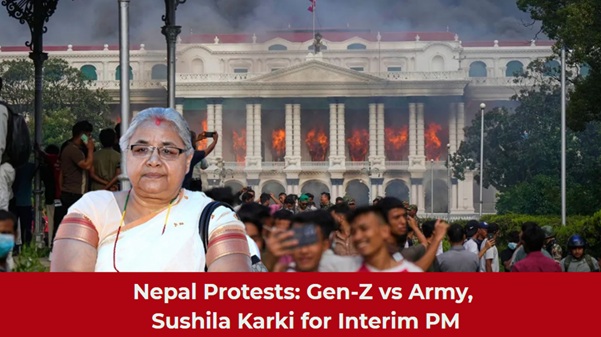Nepal, India’s Himalayan neighbor, has been gripped by political turmoil for three consecutive days as Gen-Z-led protests swept across the nation. What began as demonstrations against the government’s social media ban, corruption, and political nepotism has now escalated into a full-blown national crisis, culminating in discussions about forming an interim government.
Turning Point: Army-Protesters Dialogue
On Wednesday, a significant development took place when representatives of the Nepalese Army entered into talks with Gen-Z protest leaders. These discussions, which lasted over four hours, appear to have cleared the path for a transitional administration.
During the talks, the name of 73-year-old former Chief Justice Sushila Karki emerged as the leading candidate to head the interim government. If appointed, she would not only become the country’s interim Prime Minister but also the first woman in Nepal’s history to lead at such a critical juncture.
Who is Sushila Karki?
Sushila Karki holds a historic place in Nepal’s judiciary as the country’s first female Chief Justice of the Supreme Court. Her tenure was marked by strong rulings against corruption, though she also faced a controversial impeachment motion that was eventually overturned.
Critics argue that her political connections — particularly through her husband, a senior Congress Party leader — raise questions about her neutrality. Supporters, however, view her as a reformist figure capable of steering Nepal through the current political deadlock.
The Protests: From Anger to Anarchy
The protests, initially peaceful, quickly spiraled into violence:
👉 Parliament was set on fire, symbolizing public rage against the political class.
👉 Over 40 lawmakers resigned, deepening the governance vacuum.
👉 Protesters stormed government buildings, media offices, and even the Supreme Court.
👉 Reports suggest violent attacks on political leaders’ families, underscoring the breakdown of law and order.
This pattern of unrest resembles recent upheavals in Sri Lanka (2022) and Bangladesh (2024), where street movements triggered dramatic leadership changes.
The Geopolitical Angle
Nepal’s crisis is not unfolding in isolation. It has significant implications for the regional balance of power:
👉 United States: Analysts see the “footprints” of Washington’s deep state in these events, similar to its involvement in other regime changes under the banner of democracy promotion.
👉 China: Beijing, which had close ties with the ousted leadership, has remained conspicuously silent. Its caution stems from fears of triggering anti-China sentiment among protesters, though it has heavy economic and strategic stakes in Nepal.
👉 India: New Delhi’s primary concern is the potential spillover effect across its porous borders. Security agencies have already placed Bihar and Uttar Pradesh districts on alert to prevent unrest from spreading into Indian territory.
Democracy or Street Power?
The elevation of Sushila Karki raises deeper questions about the state of democracy in Nepal. Is she being positioned as a genuine transitional leader who will oversee free elections, or merely as a stopgap figure serving external agendas?
The sudden surfacing of her candidacy echoes Bangladesh’s experience with Nobel laureate Muhammad Yunus, who was elevated as interim leader following violent protests, only to later face criticism for aligning with external powers.
What Lies Ahead
For Nepal, the immediate challenge is restoring stability without undermining democratic legitimacy. The longer-term concern is whether this uprising strengthens people’s voice or weakens democratic institutions by normalizing mob-driven regime change.
For India and the wider region, the crisis is a reminder of how fragile South Asia’s democracies remain — and how quickly local protests can become arenas for geopolitical rivalry between the US and China.
Conclusion
Nepal’s unfolding crisis is not just about youth anger or corruption. It is about who controls the narrative of democracy in South Asia. With Sushila Karki emerging as the possible interim Prime Minister, Nepal finds itself at a crossroads: either stabilizing through fresh elections or sinking deeper into political volatility shaped by external players.
The world is watching closely — and so is India.
References
https://indianexpress.com/article/world/nepal-gen-z-protest-live-updates-curfew-army-pm-10241487
Discover more from DailyDozes NEWSPAPER
Subscribe to get the latest posts sent to your email.
